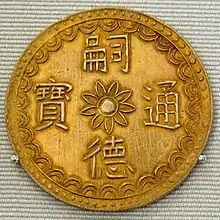Tự Đức
Tự Đức (Hanoi: [tɨ˧˨ ɗɨk̚˧˦], Hán tự: 嗣德, lit. "inheritance of virtues", 22 September 1829 – 17 July 1883) (personal name: Nguyễn Phúc Hồng Nhậm , also Nguyễn Phúc Thì) was the fourth emperor of the Nguyễn dynasty of Vietnam; he ruled from 1847 to 1883.
| Emperor Tự Đức 嗣德帝 | |||||||||||||||||
|---|---|---|---|---|---|---|---|---|---|---|---|---|---|---|---|---|---|
| Emperor of Đại Nam | |||||||||||||||||
 Emperor Tự Đức (1829–1883) | |||||||||||||||||
| Emperor of Đại Nam | |||||||||||||||||
| Reign | 5 October 1847–19 July 1883 | ||||||||||||||||
| Predecessor | Thiệu Trị | ||||||||||||||||
| Successor | Dục Đức | ||||||||||||||||
| Emperor of Nguyễn Dynasty | |||||||||||||||||
| Reign | 5 October 1847–19 July 1883 | ||||||||||||||||
| Predecessor | Thiệu Trị | ||||||||||||||||
| Successor | Dục Đức | ||||||||||||||||
| Born | September 22, 1829 Imperial City, Huế, Đại Nam | ||||||||||||||||
| Died | July 19, 1883 (aged 53) Imperial City, Huế, Đại Nam | ||||||||||||||||
| Burial | |||||||||||||||||
| Spouse | Empress Trang Ý Nguyễn Thị Bích more than 300 concubines | ||||||||||||||||
| Issue | None (Childless) Nguyễn Phúc Ưng Ái (adoptive) Nguyễn Phúc Ưng Kỷ (adoptive) Nguyễn Phúc Ưng Đăng (adoptive) | ||||||||||||||||
| |||||||||||||||||
| House | Nguyễn | ||||||||||||||||
| Father | Thiệu Trị | ||||||||||||||||
| Mother | Empress Từ Dụ | ||||||||||||||||
| Religion | Ruism, Buddhism | ||||||||||||||||
Biography
The son of Emperor Thiệu Trị, Prince Nguyễn Phúc Hồng Nhậm was born on 22 September 1829, and succeeded his father on the throne, with the reigning title of Tự Đức, but family troubles caused his era to have a violent start. Thiệu Trị had passed over his more moderate eldest son, Hồng Bảo, to give the throne to Tự Đức, known for his staunch Confucianism and opposition to foreigners and innovation. As a result, and due to the repressive policies of the previous Nguyễn Dynasty emperor, there was now a great deal of dissatisfaction with Nguyễn rule and a legitimate royal figure to rally this opposition.
Rule
Conflict with Hồng Bảo
Prince Nguyễn Phúc Hồng Bảo became the leader of a rebellion against Tự Đức, consisting of Confucian scholars who were angered that the family hierarchy had been dishonored (by passing over the eldest son) some remaining supporters of the Lê Dynasty (who many still considered the legitimate dynasty of Vietnam) as well as the usual peasants angry over Nguyễn taxation and the usual corrupt mandarins as well as the Roman Catholic missionaries and Christian converts who had been so persecuted by Minh Mạng and Thiệu Trị. With swift military force, Tự Đức suppressed the rebellion and was set to execute his brother, but was dissuaded by his mother, Dowager queen Từ Dũ, and Hồng Bảo killed himself in prison.

Religious suppression
Emperor Tự Đức continued the policies of his predecessors, shutting Vietnam off from the outside world and refusing all efforts to modernize the country. Accounts of his personal life show a gentle and educated man, but his policies brought on conflict with Europe that Vietnam could not win. He oppressed all foreigners in Vietnam, especially the Christian community, who had tried to overthrow his father, such as in the Lê Văn Khôi revolt, calling their religion a "perverse doctrine". The Christian mandarin Nguyễn Trường Tộ tried to convince Tự Đức that this was a suicidal policy, but he did not listen, confident that France was too involved with the chaos in Europe in 1848 to respond, but he was mistaken.
European conquest
France responded with a large military expeditionary force and attacked up from southern Vietnam. The Nguyễn army fought bravely for some time, but their antiquated weapons and tactics were no match for the French, who suffered more from the climate and disease than from enemy resistance. The fighting around Hanoi against the Black Flag[1] pirates ended with France victorious and China gave up their position as feudal master of Vietnam and recognized France as the ruling power over the region.
Rebellions
To make matters worse, Emperor Tự Đức had to deal with renewed internal rebellions which had become commonplace for the Nguyễn Dynasty. There were literally hundreds of small rebellions and uprisings against Nguyễn rule. Ineffective attempts to enforce the ban on Christian missionaries were also the biggest source of trouble, including the execution of a Spanish bishop which was used to justify the French and Spanish invasion that led to the fall of Saigon. By an order of 1848 Tự Đức commanded all Vietnamese Catholic converts to renounce their religion, otherwise they would be branded on the face with the mark of a heretic and surrender all of their rights and privileges. This rallied most of the European powers against Vietnam, and Tự Đức by doing this had given up any hope of Vietnam gaining help as a victim from the outside world.

Treaties
When further rebellions broke out as the French were advancing on the capital, Tự Đức feared that his authority was crumbling. He preferred to make a deal with the French so that he could crush the rebellion since while France may demand humiliating concessions, the rebels would most likely depose and/or kill him. He signed away the southernmost of Vietnam, Cochinchina, to be a French colony and accepted the status of a French protectorate for his country. This caused a huge uproar, and many, such as the famous mandarin Trương Định, refused to recognize the treaty and fought on in defense of their country, denouncing Tự Đức for surrendering any part of their homeland.
Death
Emperor Tự Đức did not live to see the worst effects of colonialism on his country, but he is often regarded as the last Emperor of Vietnam to rule independently. A case of smallpox left him impotent so he had no children despite a huge harem of wives he kept in his palace. According to legend, he died in 1883, cursing the French with his dying breath. After his death, his adopted son Dục Đức was deposed by court officials after a reign of three days.[2]
 Tomb of Emperor Tự Đức)
Tomb of Emperor Tự Đức) Pavillon and lotus pond.
Pavillon and lotus pond.
Family
| Rank | Title | Name | Date of birth-dead | Note |
|---|---|---|---|---|
| Consort Trung | Palace lady
Second rank Consort Cần First rank Consort Thuần/Trung The imperial noble consort (the same as The empress of Nguyễn dynasty) Empress Khiêm Empress dowager Trang Ý Grand Empress dowager Trang Ý Empress Lệ Thiên Anh (Lệ Thiên Anh Hoàng hậu- 儷天英皇后) |
Võ Thị Duyên | 1828-1903 | |
| Consort Thiện | Palace lady
Second rank consort Chiêu First rank Consort Thiện |
Nguyễn Thị Cẩm | ||
| Consort Học | Palace lady
Fourth rank concubine Lượng Second rank consort Khiêm First rank consort Học The imperial consort dowager (the title of the emperor's mother but not the empress of the former emperor) |
Nguyễn Thị Hương | ||
| Concubine Mẫn | Palace lady
Third rank Concubine Thận Second rank Consort Cung Third rank concubine Mẫn |
From Lê family | ||
| Concubine Lễ | Ninth rank lady
Eighth rank lady Seventh rank lady Sixth rank lady Third rank concubine Lễ |
Nguyễn Nhược Thị Bích | 1830-1909 | |
| Concubine Thận | Third rank concubine Thận | From Hồ family | ||
| Concubine Kiệm | Fourth rank concubine Kiệm | From Bùi family | ?-1893 | |
| Concubine Tín | Fifth rank concubine Tín | From Nguyễn Thanh family | ||
| Lady | Sixth rank lady | From Nguyễn Trinh family | ||
| Eighth rank lady | From Nguyễn Đình family | |||
| Ninth rank lady | From Nguyễn Nhược family | Concubine Lễ's sister | ||
| Ninth rank lady | Trương Thị Ân | |||
| Ninth rank lady | From Lê Family | |||
| And more with no informations | ||||
See also
References
- "South China in the Imperial Era: South China from 1800 to the fall of the Qing in 1911". CPA Media. 2008. Archived from the original on 30 August 2010. Retrieved 9 July 2010.
[...] the Black Flags and their leader, Liu Yung-fu, were to acquire a certain dubious legitimacy and fame in the service both of the Vietnamese king, Tu Duc, and of the latter's Qing suzerains in their struggle against French imperialism in Tonkin.
- Bruce M. Lockhart, William J. Duiker Historical Dictionary of Vietnam 2010 -Page 154 "A younger brother and adopted son of Emperor Tự Đức, he succeeded his nephew Dục Đức after the latter was deposed by court officials in 1883. Hiép Hoa attempted to wrest power back from these officials, but he was not strong enough"
External links
| Wikimedia Commons has media related to Emperor Tự Đức. |
| Preceded by Emperor Thiệu Trị |
Nguyễn Dynasty | Succeeded by Emperor Dục Đức |